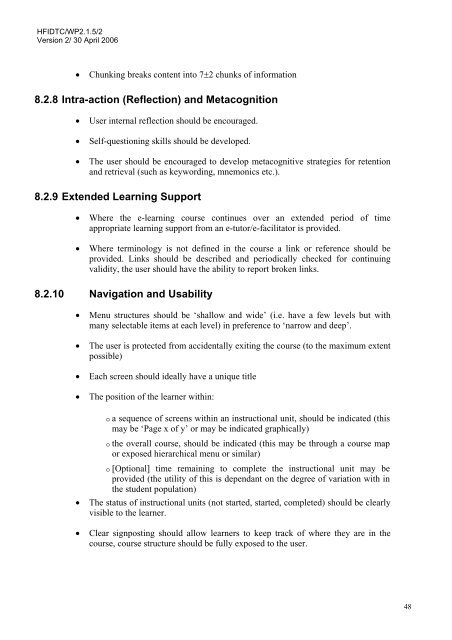E-learning Instructional Design Guidelines - Human Factors ...
E-learning Instructional Design Guidelines - Human Factors ...
E-learning Instructional Design Guidelines - Human Factors ...
Create successful ePaper yourself
Turn your PDF publications into a flip-book with our unique Google optimized e-Paper software.
HFIDTC/WP2.1.5/2<br />
Version 2/ 30 April 2006<br />
• Chunking breaks content into 7±2 chunks of information<br />
8.2.8 Intra-action (Reflection) and Metacognition<br />
• User internal reflection should be encouraged.<br />
• Self-questioning skills should be developed.<br />
• The user should be encouraged to develop metacognitive strategies for retention<br />
and retrieval (such as keywording, mnemonics etc.).<br />
8.2.9 Extended Learning Support<br />
• Where the e-<strong>learning</strong> course continues over an extended period of time<br />
appropriate <strong>learning</strong> support from an e-tutor/e-facilitator is provided.<br />
• Where terminology is not defined in the course a link or reference should be<br />
provided. Links should be described and periodically checked for continuing<br />
validity, the user should have the ability to report broken links.<br />
8.2.10 Navigation and Usability<br />
• Menu structures should be ‘shallow and wide’ (i.e. have a few levels but with<br />
many selectable items at each level) in preference to ‘narrow and deep’.<br />
• The user is protected from accidentally exiting the course (to the maximum extent<br />
possible)<br />
• Each screen should ideally have a unique title<br />
• The position of the learner within:<br />
o a sequence of screens within an instructional unit, should be indicated (this<br />
may be ‘Page x of y’ or may be indicated graphically)<br />
o the overall course, should be indicated (this may be through a course map<br />
or exposed hierarchical menu or similar)<br />
o [Optional] time remaining to complete the instructional unit may be<br />
provided (the utility of this is dependant on the degree of variation with in<br />
the student population)<br />
• The status of instructional units (not started, started, completed) should be clearly<br />
visible to the learner.<br />
• Clear signposting should allow learners to keep track of where they are in the<br />
course, course structure should be fully exposed to the user.<br />
48
















